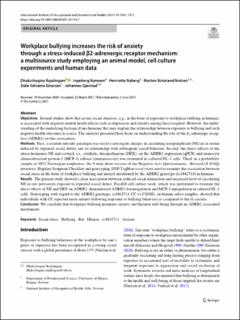| dc.description.abstract | Objectives Several studies show that severe social stressors, e.g., in the form of exposure to workplace bullying in humans, is associated with negative mental health effects such as depression and anxiety among those targeted. However, the understanding of the underlying biological mechanisms that may explain the relationship between exposure to bullying and such negative health outcomes is scarce. The analyses presented here focus on understanding the role of the β2-adrenergic receptors (ADRB2) on this association. Methods First, a resident-intruder paradigm was used to investigate changes in circulating norepinephrine (NE) in rat serum induced by repeated social defeat and its relationship with subsequent social behavior. Second, the direct effects of the stress-hormones NE and cortisol, i.e., synthetic dexamethasone (DEX), on the ADRB2 expression (qPCR) and monocyte chemoattractant protein-1 (MCP-1) release (immunoassay) was examined in cultured EL-1 cells. Third, in a probability sample of 1052 Norwegian employees, the 9-item short version of the Negative Acts Questionnaire—Revised (S-NAQ) inventory, Hopkins Symptom Checklist and genotyping (SNP TaqMan assay) were used to examine the association between social stress in the form of workplace bullying and anxiety moderated by the ADRB2 genotype (rs1042714) in humans. Results The present study showed a clear association between reduced social interaction and increased level of circulating NE in rats previously exposed to repeated social defeat. Parallel cell culture work, which was performed to examine the direct effects of NE and DEX on ADRB2, demonstrated ADRB2 downregulation and MCP-1 upregulation in cultured EL-1 cells. Genotyping with regard to the ADRB2 genotype; rs1042714 CC vs CG/GG, on human saliva samples, showed that individuals with CC reported more anxiety following exposure to bullying behaviors as compared to the G carriers. Conclusion We conclude that workplace bullying promotes anxiety and threaten well-being through an ADRB2 associated mechanism. | |
